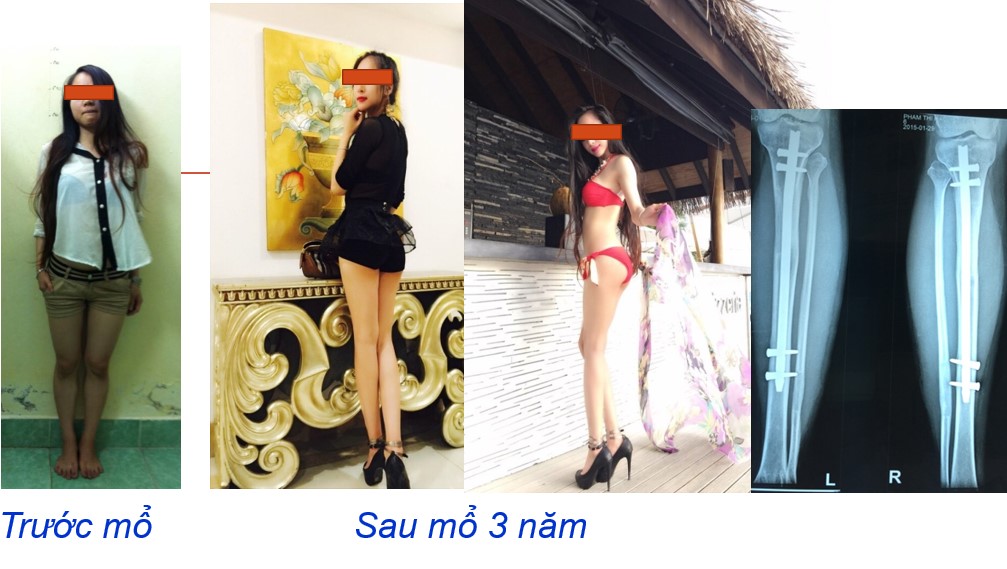
A study of people with short stature
The notions on people with short stature varies depending on the each individual’s judgement, race and time. Short stature is only a relative concept when talking about height.
We can take a person’s height that is less than the average height (by gender and age group) minus 2 times the standard deviation of the average height to evaluate if that person has short stature. According to survey data published in 2003 by the Vietnamese Ministry of Health, at the age of 20-24, the height of men is 163.72 ± 4.67 cm and that of women is 153 ± 4.32 cm; at the age of 25-29, the height of male is 163.71 ± 4.77 cm and that of female is 152.73 ± 4.12 cm.

Short stature is a result of many affecting factor including genetic makeup; gonadal, pituitary and thyroid hormones; rickets or a mixture of various forms. In addition to the above factors, short people can be divided into two main groups:
- Dwarf: These are people with short stature caused by dysplasia. These people are very short compared to the average person and have disproportionate body parts and deformed bones. Patients require a plan for leg, thigh, and arm lengthening from an early age, with multiple stages of treatment.
- People with short stature that is not caused by dysplasia sản (constitutional short stature; low normal stature): These people are not too short compared to the average person and dó not have disproportionate body parts.
A beautiful body must not only possess the ideal height, but also need to have proportional body parts, especially the length of the legs compared to the torso. The Vallois and Skelie indexes have been used in anthropometry to assess the proportion between the limbs and the torso.
Vallois index (torso index) = Sitting height x 100/Standing height.
Based on the Vallois index, we can divide people into the following groups:
- Short torso if the Vallois index is equal or less than 50.9.
- Average torso if the Vallois index is between 51 and 52.9.
- Long torso if the Vallois index is equal or greater than 53.
Skelie index (leg index) = Lower limb length x 100/Sitting height
Lower limb length = Standing height – Sitting height
Based on the Skelie index, we can divide people into the following groups:
- Short legs if the Skelie index is equal or less than 84.9. In particular, people have very short legs if the Skelie index is less then 74.9; people have relative short legs if the Skelie index is between 75 and 79.9; people have slightly short legs if the Skelie index is between 80 and 84.9.
- Average legs if the Skelie index between 85 and 89.9.
- Long legs if the Skelie index is greater than 90. In particular, people have slightly long legs if the Skelie index is between 90.1 and 94.9; people have relative long legs if the Skelie index is between 95 and 99.9; people have very long legs if the Skelie index is greater than 100.
Leg lengthening characteristics for people with short stature:
It is necessary to carefully study the reproductive history, the growth in stature during adolescence, the time of puberty, and the hormones history. People with early puberty, hormone deficiency, childhood illnesses, genetic diseases, etc. have a high risk of short stature. Family history also needs to be carefully studied, including the parents and siblings. Psychological status also needs to be assessed. Is the person’s psychology affected or is he having an inferiority complex due to his short stature? How are the frequency of effects and general psychological status? From there, the surgeon can select patients with good indications to perform leg lengthening. These are people who have often inferiority complex due to their short stature, but in other aspects of their lives they are still successful, happy, active and most importantly these patients have realistic expectations of what leg lengthening surgery can do for them that are not just merely associated with cosmetic benefits. Leg lengthening surgery is only for those who feel the need to do it and are mentally healthy.
At the same time, it is necessary to have examinations to assess the height and range of motion of the joints. Is there any damage to the nerve and blood vessels? Is there any joint deformity? Is the limb deformed? What are the measurements of the legs and does leg length discrepancy exist? X-ray scan of the lower limbs should be taken to evaluate the limb axis, tibial and femur length. Diameters of the femur and tibia where they are narrowest on straight and inclined film should be measured.
The age suitable for leg lengthening:
Currently, there is no the upper age limit for leg lengthening. Leg lengthening can be performed after the person stop growing in height, when the X-ray scan of the leg shows no cartilage which is usually over the age of 18. There has been a case of leg lengthening in the world in which the patient was 47 years old at the time.
The position and the increased length:
The position of leg lengthening can be at the shank, thigh or both. However, most doctors would choose the two shanks to perform leg lengthening. The reason behind this decision is to avoid disproportionate body and reduce treatment time and cost in comparison with those of the procedure on two thighs.
Assoc. Prof., Ph.D. Le Van Doan as the special guest to the Conference on leg lengthening in Ho Chi Minh City, December 2018

